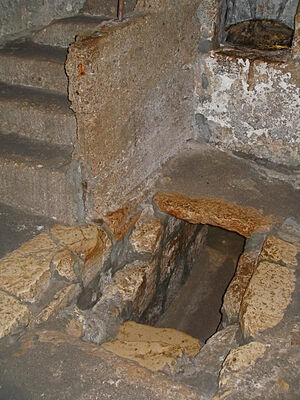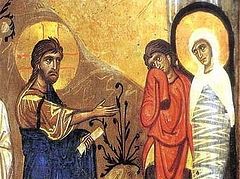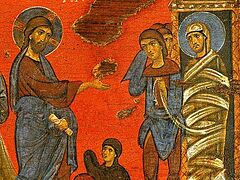 Entrance to Lazarus' burial chamber. Photo: wikipedia.org Two deep descents lead to St. Lazarus’ tomb in Bethany. First, there are steps made of large stones, which are difficult to walk down because they are so high and steep, and then there is a quick descent down into the tomb.
Entrance to Lazarus' burial chamber. Photo: wikipedia.org Two deep descents lead to St. Lazarus’ tomb in Bethany. First, there are steps made of large stones, which are difficult to walk down because they are so high and steep, and then there is a quick descent down into the tomb.
What happened then, in the air frozen with expectation over the inhabitants of Bethany, who had come running to the cave, when the voice sounded that had already raised the son of the widow of Nain and the daughter of Jairus from the dead: Lazarus, come forth (Jn. 11:43)?
And how in these days of repentance and fasting these powerful words sound like an appeal to sinners! And each of us, like a new Lazarus, heeds the Divine command...
Come forth from the snares of sin you are wallowing in; come forth from the worldly chains in which you are shackled; come forth from the “cave” of despair and enslavement to the dark forces of evil; and come forth to the sun, freedom and the world of the Lord's grace!...
Thunder, thunder over the world where so many dead Lazaruses are waiting for You; thunder with Thy miraculous call, O Christ.
And as over Lazarus, O Savior,
Weep a little over me.1
And after this miracle follows the triumphant Entry into Jerusalem. The people spread their clothes along the road, breaking and cutting off branches of olive and fig trees, and scattering them along the road. And loud cries are rising above all this jubilation: “Hosanna to the Son of David! Blessed is He that cometh in the Name of the Lord! Hosanna in the highest!"
Gradually ascending the Mount of Olives among the trees and green fields, the road turns sharply to the north, and then Jerusalem suddenly opens up, previously hidden by a spur of the mountain. The marble tops of church buildings gleamed in the crystal clear sunlit air. The view from here was so beautiful that travelers were often stupefied before it. And the jubilant people joined this beauty...
And we, holding pussy willow (“northern palms”) branches in our hands, listening to the greeting that magnificently echoes the cries of the Jewish children: “Hosanna to the Son of David! Hosanna in the highest!”
The candles are quietly melting in our hands, and the greetings of our pussy willows are faint. They have brought with them the caress of the awakening spring and the gentle murmur of the brook over which they grew, and the thoughtful whisper of forests. These pussy willows, which are turning green and will bud, and the quiet melting of wax, somehow tenderly speak of the general resurrection of the dead, heralded by the miracle over St. Lazarus, performed by Christ at the end of His life’s journey, “giving us before His Passion an assurance of the general resurrection”, as we sing in the troparion of this feast.
From the book, Ideals of Christian Life



